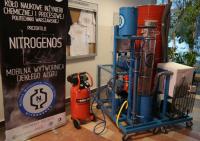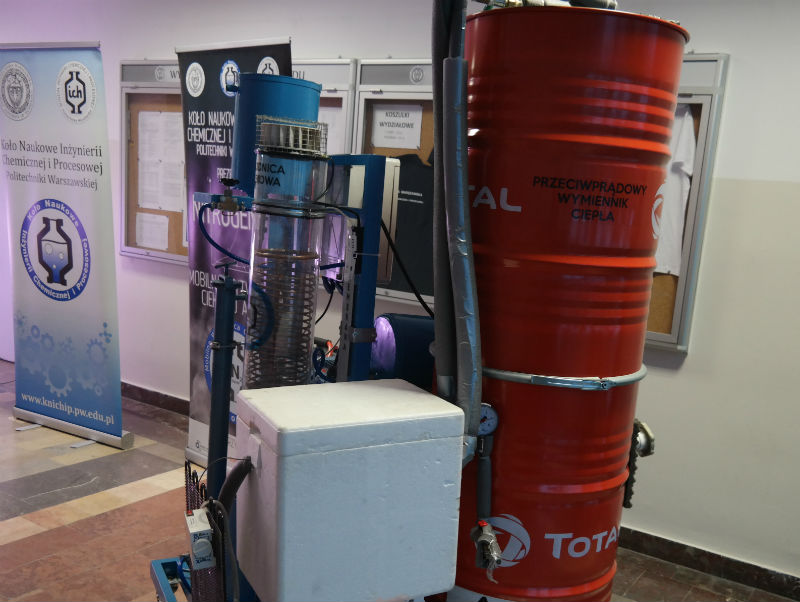Students from the Warsaw University of Technology create a Mobile Liquid Nitrogen Generator
They needed a source of liquid nitrogen for demonstrations and research. So they decided to construct the necessary device themselves. Ten months later they proudly showed off Nitrogenos to the world. The idea of the Scientific Society of Chemical and Process Engineering is already attracting interest from the industry and has recently won an award at the StRuNa 2016 competition for societies and other student organisations from all over Poland.
The project was initiated and coordinated by Michał Wojtalik. “I called some colleagues, asking them to do this project with me,” he recalls, “and they agreed. At the time they had no idea how much work awaited us.”
Practice differs from theory
The students performed design calculations for individual system components and verified them through computer simulations. On the basis of this documentation, they built Nitrogenos. “The fact that we could do it ourselves was the best part,” Wojtalik says. “Designing is cool, but then you don't have the thrill that you get when you first start up your own device.”
Working on Nitrogenos allowed the students to put knowledge they acquired during their studies into practice. “It's slightly different than in theory, everything is much more complicated,” Wojtalik notes. “For example, it's assumed that cooling a gas is easy, but it turns out that it's not that simple, as we have 3 cooling stages in our case.”
As the project manager acknowledges, the difficulty lay in the multitude of small, seemingly trivial things that need to be resolved. “They're often nuances that can later be useful when working,” he says. “We now know which elements needed for such a system are available on the market, how much they cost, which can be bought cheaper, we know how to accomplish a specific process and we have usable technical and design solutions. For example, after this project we know that it's better to weld a nipple into the flange than to machine the flange, as it's many times cheaper.”
More money = better performance
Nitrogenos uses a traditional thermodynamic cycle. “The installation is cheap to produce,” Wojtalik says. “It allows us to obtain approximately 300 ml of liquefied nitrogen per hour from atmospheric air. That's a lot for a device of this category.”
Funds for its construction came from the Small Pool for Scientific Projects of the Scientific Societies' Council of the Warsaw University of Technology 2015, additional financing from the Didactic Commission of the Warsaw University of Technology Student Government, a Rector's Grant for the Scientific Societies of the Warsaw University of Technology and a donation from the Dean of the Faculty of Chemical and Process Engineering. These totaled approximately PLN 25 000. Very little given the scale of the project. There wasn't enough money for, among other things, automating the cooling process (which means that someone must constantly operate the installation) or vacuum jackets on the heat exchangers (which translates into a lower efficiency of Nitrogenos – with better insulation it might even be possible to obtain a litre of nitrogen per hour).
Obstacles are there to be overcome
The students were repeatedly faced with ever new challenges over the course of their work.
“The vessel has a countercurrent heat exchanger built using two copper tubes: a twelve millimetre one and a six millimetre one,” says Wojtalik. “We had to insert one tube into the other and each is 40 meters long. It took us a couple months to figure out how to do it. We couldn't convince the workshop to do this because the tubes are quite expensive and no one wanted to take responsibility. In the end, when the men in the workshop saw that we managed to insert 10 metres, they agreed. Everyone is surprised that it's possible and it works. The exchanger, although it's the simplest possible type and such a type would not be used in an industrial context, exhibits fairly good performance of 230 W of heat load at an operating pressure of about 220 bar.”
Another problem also needed to be solved – how to effectively separate nitrogen from oxygen. Members of the Chemical and Process Engineering Scientific Society rejected the first idea, pressure swing adsorption,because it was too expensive. Eventually, they settled on the much cheaper membrane process. “We managed to achieve 1.5-2% nitrogen purity, which is enough for our device,” Wojtalik explains.
One has to be very careful when working on obtaining liquid nitrogen. The fact that atmospheric air has 79% nitrogen and 21% oxygen, doesn't mean that it will remain so after liquefaction. “The distribution changes and we even reach 50% oxygen, so we're approaching liquid oxygen, which is so dangerous that sometimes contact with an oily floor is enough for immediate ignition,” Wojtalik notes. “This is a problem for us. We need to gather quite a lot of gas in the installation. Bringing oxygen down to the appropriate concentrations takes almost an hour.”
A good team is a key to success
Aside from Michał Wojtalik, two core members of the team were Patryk Baran and Michał Fedoryk. Electrical issues were handled by Jakub Syczewski and Łukasz Górski. The project also included Paweł Antkowiak, Julia Bień, Nina Borzęcka, Wiktor Dobryniewski, Eliza Grzymkowska, Krystian Jędrzejczak, Marcin Kryczka, Radosław Krzosa and Kacper Siwek. “We made a very good team. One that worked hard for 10 months,” Wojtalik notes. “That's really valuable.”
The students could also count on help from DSc. Piotr Machniewski, who teaches process thermodynamics at the Faculty of Chemical and Process Engineering. “He would talk with us for 3-4 hours about the installation and we had many such meetings,” Wojtalik says.
A question of trust
So far, the project manager presented Nitrogenos to a company that manufactures ice cream. “It's hard to convince someone that the fact that we've built such a small installation means that we can scale it up to fit in with the food industry’s needs,” he explains. “Somebody will have to put their trust in us.”
As Wojtalik calculated, the student team from the Warsaw University of Technology would be able to build a suitable device, with a capacity of about 10 litres per hour, for half a million Polish zlotys at most. That's half the standard cost of this type of installation on the market. “The price is so low mainly because we have the most important part of the technology under control, while the main problems have been identified and there are effective methods to resolve them,” Wojtalik explains.
Agnieszka Kapela
Office of Promotion and Information









